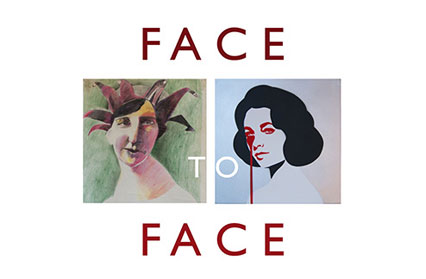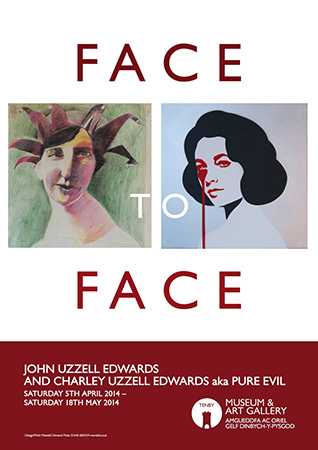John Uzzell Edwards and Charlie Uzzell Edwards
Face to Face
Tenby Museum and Art Gallery
John Uzzell Edwards died on March 5th. As a result Tenby’s planned exhibition, featuring father and son artists on opposite walls, was amended. The re-selection of fifteen pictures became broader, drawing from work across several decades, albeit all representing the human form. The result in Tenby’s Face to Face exhibition is not just a worthy valediction but a visually bracing tribute to art, and ideas of art, across the generations.
Stylistically the work on show of the elder Uzzell Edwards may be roughly divided in three. Some of the figures, with a ghost of Bacon in them, are achieved with savage brushstrokes. The features on ‘Carnival Figure’ are unidentifiable. The media are varied with ‘Welsh Deacon’ in wash and crayon and ‘Celtic Poet II’ in watercolour. The most salient feature in the powerful ‘Gladys’ in oil is a set of bared teeth.
Uzzell Edwards had a liking for a phrase from Dylan Thomas ‘the yellowing dicky-bird-watching pictures of the dead’. There was a point, he observed, where faces waiting for the shutter of the camera to click acquire a particular stillness. The artist assumes a critical distance for some pictures. ‘Two Sisters’ is executed in chalk, ‘Choir Lady’ in acrylic. A ‘Harlequin Trio’ is represented as sober in character, their eyes wayward and noses twisted. A large hand and exaggerated nose feature too in ‘Welsh Miner’. For ‘Choir Lady’ the pupil of an eye is achieved with a dab of diagonal black.
Thirdly, there are subjects close to the artist who are given a treatment of insightful sympathy. ‘Grey Miner’ with powerful features and a prominent moustache is depicted within an umbra of colours that shimmer. ‘Poet’ has a gently gazing intensity of sadness to him.
John Uzzell Edwards received a characteristically eloquent obituary from Meic Stephens in The Independent. The differing artistic lives of father and son could not be more emblematic of the social and economic earthquakes of the last eighty years. John Uzzell Edwards from a hard-pressed Valleys family had a yearning to make art, a fitful part-induction and a self-driven apprenticeship. Charlie Uzzell Edwards’ six spray-painted canvases, their forms mediated by application of a stencil, have as different a genesis as might be.
Charlie Uzzell Edwards came to art via a period in California and the creation of clothing for the label ‘Anarchic Adjustment’. Back in Britain his work has had the rare status of featuring on The Apprentice when the wannabes were set to flogging art. He is described as belonging to the class of ‘the accidental gallerist’, a description that belies the record of fifty exhibitions from Brazil to Mongolia. He has adopted a moniker ‘Pure Evil’.
The presentation of the artist has an element of play to it. Firstly, he makes claim to a breadth of significant ancestry. A family background claims, among many, Sir Thomas More and Ailric a King’s thane from Saxon times. The work on show has its own ancestry in the genres of pop art and graffiti but the pared-down simplicity is weighed with moral gravity.
The canvases are similarly sized, around a metre square, similarly titled and similarly created. The colours are few, four or five. Each represents a woman, and a wife, of celebrity, Bardot, Elizabeth Taylor, Ava Gardner. Beneath one left eye a uniformly coloured, giant tear has swelled. The line continues down the gallery wall via coloured tape and ends on the floor. The tears gather in a small pool made with a pad of coloured vinyl. The effect is at once both stark, arresting and conceptually novel.
Tenby’s Museum and Gallery on its hillock above the beach is a gem; the view from its west-facing window is the most dramatic of any in Wales. Its main gallery is both compact and filled with treasure. A Gwen John portrait is one of the greatest to be seen in any public gallery. It is a venue too that invites affection. One visitor made enquiry whether the collection included a Kyffin Williams – the answer was no. Shortly afterwards the drawing that is now on display arrived, unsolicited, by post. The permanent collection and the Uzzell Edwards’ exhibition make for stimulating complementary companions; Face to Face is a fine valediction.













